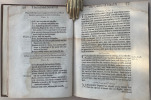The Castle of Health,
Corrected, and in some places Augmented by the first authour thereof, Sir Thomas Elyot [Knight]. NOW NEWLIE PERused, amended, and corrected, this present year 1610. - A publisher's stamp - LONDON, Printed for the Company of Stationers, 1610.
139 x 178 x 15 mm. 1fep. Title page. [1] 5 pages A Proheme of Sir Thomas Elyot. Verso blank. 4 pages A Table. The First Book 13 - 22. The Second Book 22 - 80. The Third Book 80 - 112. The Fourth Book 112 - 140. 1fep. The title page quite browned and with a stain. A stain running from the title page to page 30, although not affecting text. Cropped at the top of the block with capital page headings in all pages slightly cropped but mostly still readable. A modern full brown calf binding with nicely and sympathetically blind-stamped boards. Spine with blind stamped raised bands and title in gilt.
- Thomas Elyot was the child of Sir Richard Elyot's first marriage with Alice De la Mare, but neither the date nor place of his birth is accurately known. It was claimed Elyot was an alumnus of St Mary Hall, Oxford, while the 'Athenae Cantabrigienses' put in a claim for Jesus College, Cambridge. Elyot himself says in the preface to his Dictionary that he was educated under the paternal roof, and was from the age of twelve his own tutor. In 1511 he accompanied his father on the western circuit as clerk to the assize, and he held this position until 1528. In addition to his father's lands in Wiltshire and Oxfordshire he inherited in 1523 the Cambridge estates of his cousin, Thomas Fynderne. His title was disputed, but Cardinal Wolsey decided in his favour, and also made him clerk of the Privy Council. Elyot, in a letter addressed to Thomas Cromwell, says that he never received the emoluments of this office, while the empty honour of knighthood conferred on him when he was displaced in 1530 merely put him to further expense. In that year he sat on the commission appointed to inquire into the Cambridgeshire estates of his former patron, Wolsey. He was in 1527 appointed High Sheriff of Oxfordshire and Berkshire. In 1531 he received instructions to proceed to the court of Charles V, the Holy Roman Emperor, to try to persuade him to take a more favourable view of Henry V111's proposed divorce from his first wife, Catherine of Aragon, the emperor's aunt. As ambassador Elyot was involved in ruinous expense, and on his return he wrote unsuccessfully to Cromwell begging to be excused, on the grounds of his poverty, from serving as High Sheriff of Cambridgeshire and Huntingdonshire for 1532. He was one of the commissioners in the inquiry instituted by Cromwell prior to the suppression of the monasteries but he did not obtain any share of the spoils. There is little doubt that his known friendship for Thomas More militated against his chances of success, for in a letter addressed to Cromwell he admitted his friendship for More, but protested that he rated higher his duty to the king. From 1539 to 1542 he represented the borough of Cambridge in parliament. He had purchased from Cromwell the manor of Carleton in Cambridgeshire, where he eventually died. Elyot received little reward for his services to the state, but his scholarship and his books were held in high esteem by his contemporaries. As a prose writer, Elyot enriched the English language with many new words. In 1536 he published the first edition of 'The Castell of Health', which was a popular treatise on medicine, intended to place a scientific knowledge of the art within the reach of those unacquainted with Greek. This work, though scoffed at by the faculty, was appreciated by the general public, and speedily went through seventeen editions. These writings and knowledge of the time had a large effect on cooks as well. We see that the cookery books of the next century were much more developed and numerous. The hunger and need for people to improve the quality of life and health always pushes the need for pragmatic solutions. In the first half of the next century we see cookery books with 50% cookery and 50% medical advice side by side. This practice started to die out in the later part of the century where medical books stood alone next to books only with cookery recipes and advice. Besides this edition of 1610, some of the other books on Health in the same century by other authors are ; 'The Garden of Health' by William Langham 1633. 'The Haven of Health' by Thomas Cogham 1636. 'Regimen Sanitatis Salerni' Anon. 1649. 'Via Recta Ad Vitam Longam' by Thos. Venner 1650. 'The Rules of Health and Food' by Thomas Moffat 1655. 'The Way to Health' by Thomas Tryon 1691.






click on image to enlarge

Antiquarian category
ref number:
11253